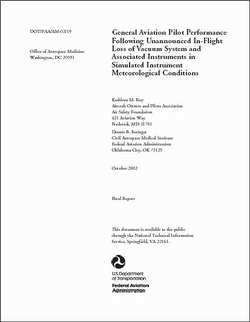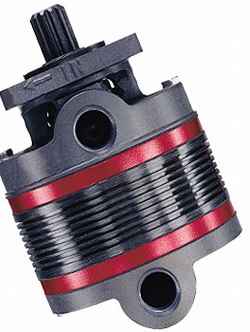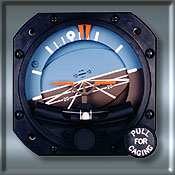Proper Training Makes Pilots Better Able to Cope with Vacuum
Pump Failures in IFR Conditions
 A new study by the AOPA Air Safety Foundation and
FAA's Civil Aerospace Medical Institute (CAMI) shows that pilots
are better able to cope with a vacuum pump failure in actual
aircraft than previous simulator-based studies had reported.
A new study by the AOPA Air Safety Foundation and
FAA's Civil Aerospace Medical Institute (CAMI) shows that pilots
are better able to cope with a vacuum pump failure in actual
aircraft than previous simulator-based studies had reported.
"We expected that pilots receive more sensory inputs during an
actual flight than in a simulator," said ASF Executive Director
Bruce Landsberg. "In fact, that appears to be the case. Our study
pilots fared somewhat better in the actual aircraft than the pilots
in earlier studies using only visual simulators, particularly in
complex aircraft."
A vacuum pump failure disables the attitude and heading
indicator in most general aviation aircraft, leading to the
possibility of spatial disorientation for pilots flying in
instrument conditions. About three accidents a year are attributed
to spatial disorientation due to a vacuum pump or instrument
failure.
Despite that relatively low number of accidents, some previous
studies using only visual simulators suggested that the majority of
pilots in aircraft with retractable landing gear weren't prepared
to deal with the emergency and fly with the remaining instruments,
known as "partial panel" flying.
But the ASF/CAMI study using real aircraft showed that the loss
of the attitude indicator or other gyroscopic instruments need not
be a killer if a pilot receives adequate training and keeps current
on the ability to recognize a vacuum system failure and fly with
reference to a partial panel.
 In the study conducted during 2001 in actual
aircraft, all 41 test subjects were instrument-rated pilots. Their
ages and levels of experience covered a wide spectrum. The test
subjects flew one of two aircraft modified to simulate failure of
the attitude and heading instruments without the pilots' knowledge.
Each was told that he or she would be part of a study to evaluate
pilot performance under simulated instrument meteorological
conditions (IMC).
In the study conducted during 2001 in actual
aircraft, all 41 test subjects were instrument-rated pilots. Their
ages and levels of experience covered a wide spectrum. The test
subjects flew one of two aircraft modified to simulate failure of
the attitude and heading instruments without the pilots' knowledge.
Each was told that he or she would be part of a study to evaluate
pilot performance under simulated instrument meteorological
conditions (IMC).
The pilots were divided into two groups: one flying a Piper
Archer (PA-28) and one flying a Beechcraft Bonanza (A36). The
Archer pilots were subdivided into three groups, each of which
suffered the loss of attitude indicator and heading indicator.
- Group 1: No annunciator warning light, no training provided
prior to the flight
- Group 2: 30 minutes simulator training provided prior to
flight, no annunciator warning light
- Group 3: Vacuum failure warning annunciator light, no training
provided prior to flight
The Bonanza pilots were divided into two groups:
- Group 1: Attitude indicator failure
- Group 2: Attitude indicator failure and horizontal situation
indicator (HSI) failure
 On average, the Archer pilots took longer to
recognize the failure than did the Bonanza pilots (6.7 minutes vs.
3.6 minutes), but all Archer pilots successfully concluded the
flight. Significantly, the Archer pilots who received the simulator
training spotted the problem more quickly than the others (4.9
minutes vs. 6.7 minutes), although the annunciator light did not
appear to give the pilots in the third group any advantage over the
pilots in the first two groups. It should be noted that the
annunciator was not easily visible in the daylight.
On average, the Archer pilots took longer to
recognize the failure than did the Bonanza pilots (6.7 minutes vs.
3.6 minutes), but all Archer pilots successfully concluded the
flight. Significantly, the Archer pilots who received the simulator
training spotted the problem more quickly than the others (4.9
minutes vs. 6.7 minutes), although the annunciator light did not
appear to give the pilots in the third group any advantage over the
pilots in the first two groups. It should be noted that the
annunciator was not easily visible in the daylight.
While the Bonanza pilots recognized the problem more quickly
than the Archer pilots, four of the 16 were deemed to have lost
control and "crashed." All of the "crashes" occurred in the second
Bonanza group, which lost both attitude indicator and HSI.
"The results of the second Bonanza group indicate the crucial
role backup systems play," said Landsberg. "Having a mix of power
sources for vacuum-driven instruments can greatly increase a
pilot's ability to deal with the failure of some flight
instruments."
 Both in previous simulator studies and the
ASF/CAMI study using aircraft, there appeared to be a correlation
between the complexity of the aircraft and the ability to safely
conclude a flight after instrument failure. An independent CAMI
study in 2001 simulated unannounced vacuum failure in two visual
simulators, a Cessna 172 and a Piper Malibu, and found a much
higher loss-of-control rate in the more complex Malibu (83 percent)
than in the 172 (8 percent). In a similar ASF study in 2000 by C.R.
Martinez using Cessna 208 and Cessna 210 simulators, two thirds of
the 24 test subjects lost control and half "crashed."
Both in previous simulator studies and the
ASF/CAMI study using aircraft, there appeared to be a correlation
between the complexity of the aircraft and the ability to safely
conclude a flight after instrument failure. An independent CAMI
study in 2001 simulated unannounced vacuum failure in two visual
simulators, a Cessna 172 and a Piper Malibu, and found a much
higher loss-of-control rate in the more complex Malibu (83 percent)
than in the 172 (8 percent). In a similar ASF study in 2000 by C.R.
Martinez using Cessna 208 and Cessna 210 simulators, two thirds of
the 24 test subjects lost control and half "crashed."
Other factors, such as age, currency, and experience, appear not
to have played a role in determining which pilots would
successfully conclude their flights and which would not.
"The studies point out the need to know emergency procedures if
something does go wrong," said Landsberg. "In addition, the Air
Safety Foundation recommends that pilots of complex aircraft lower
their landing gear if they suspect a vacuum failure, to help
maintain stability and to lower airspeed. However, there is no
substitute for training, practice, and redundant systems, where
possible."
 ANN's Daily Aero-Linx (05.06.25)
ANN's Daily Aero-Linx (05.06.25) ANN's Daily Aero-Term (05.06.25): Ultrahigh Frequency (UHF)
ANN's Daily Aero-Term (05.06.25): Ultrahigh Frequency (UHF) ANN FAQ: Q&A 101
ANN FAQ: Q&A 101 Classic Aero-TV: Virtual Reality Painting--PPG Leverages Technology for Training
Classic Aero-TV: Virtual Reality Painting--PPG Leverages Technology for Training Airborne 05.02.25: Joby Crewed Milestone, Diamond Club, Canadian Pilot Insurance
Airborne 05.02.25: Joby Crewed Milestone, Diamond Club, Canadian Pilot Insurance






